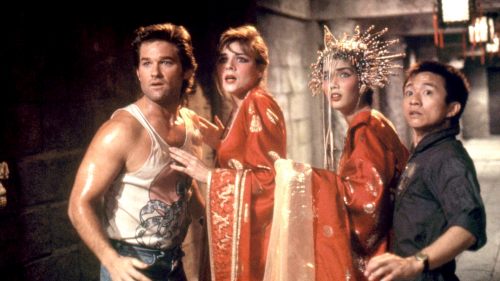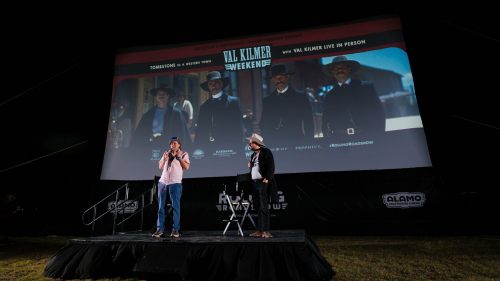Showdown At Two OK Corrals
Tombstone, or the first version of the Kevin Jarre script that eventually became Tombstone, was intended to be a Kevin Costner picture. But after Costner read Jarre's script and tussled with the writer over the focus - Jarre believed Tombstone should feature the wide cast of colorful characters surrounding the lawman, while Costner wanted the movie to zero in on Earp himself - Costner left the film and entreated his friend Lawrence Kasdan to make their own version of the story, one that followed Earp through the long years of his life, rather than centering on his brief and tumultuous time in Tombstone, Arizona. That project was at first meant to be a mini-series, keeping it in a separate arena from Tombstone, but for various reasons Costner ultimately decided to make Wyatt Earp a feature film. (Though, granted, one of equivalent running time to a mini-series.)
Kevin Jarre and Kurt Russell, for whom Tombstone was a long-cherished passion project, were gutted. Costner was not an obligatory ingredient for their film, but he was one of the biggest movie stars and most powerful Hollywood players of the time - and now that he had his own Wyatt Earp project in the works, he made for stiff competition.
“I got a phone call, and it was just before Val was going to come on—we had to have a release. Costner had shut down all avenues of release for the picture except for Disney, except for Buena Vista. …He was powerful enough at the time, which I always respected. I thought it was good hardball.”
Costner's story differs here - he maintained "that he personally went to Universal and asked them to release the Jarre version into turnaround and let another studio pick up the project, which is what happened. (Tombstone producer James Jacks said that Universal canceled the project when Costner announced he would make a feature film version of Earp's life, but they would not release the project to be shopped around.)" However it happened, suddenly Tombstone and Wyatt Earp were both in pre-production, and Hollywood cheerfully sat back to watch the scrimmage unfold.
After the announcement that two Wyatt Earp films would be released within six months of each other, there was a distinct David and Goliath narrative running through the trades. Kevin Costner and Lawrence Kasdan were reteaming after the solid box office and critical acclaim of Silverado, and they were bringing such heavy-hitters as Dennis Quaid, Gene Hackman and cinematographer Owen Roizman with them.
As for Tombstone, well, Kevin Jarre had never directed a film and only had a Rambo sequel and the critically loved but little-seen Glory to his name as a screenwriter. Kurt Russell had been steadily working and earning genre fans' adoration since 1962, but still did not have the box office draw of Costner, who was coming off a string of blockbusters and even a few critical darlings. It just didn't seem a fair fight.
Tombstone had the advantage of going into production first, and they quickly monopolized the available period props and clothing, leaving Wyatt Earp to resort to European imports, delaying the film somewhat. But this advantage didn't last, as Tombstone was riddled with problems during production. Robert Mitchum was injured on set and his role had to be cut from the film, though he stayed on as narrator. The inexperienced Jarre was replaced as director shortly after filming began - he was over schedule and over budget, and refused to cut any of the screenplay that everyone else agreed was about thirty pages too long. With the film two weeks behind, Disney rushed to hire George P. Cosmatos as director, as Cosmatos had successfully worked with Jarre and Tombstone producer Andrew G. Vajna on 1985's Rambo: First Blood Part II.
After the passing of Cosmatos in 2005, it became somewhat common knowledge that Russell was ghost-directing for Cosmatos, who had sunk millions of his own money into Tombstone and felt a genuine investment in its success. By secret notes and sign language, Kurt Russell led the production through its final weeks.
Meanwhile, Kasdan was making his own changes on the set of Wyatt Earp. Dan Gordon's original screenplay was the one that attracted Costner away from Jarre's, but Kasdan hated the thing. Kasdan rewrote the screenplay, saying, "I used some elements from that other script, but only the things I really loved, and there weren't that many." Although a comparison of the two scripts shows more in common than Kasdan or Gordon would admit, Gordon also didn't mince words when it came to Kasdan's version: "[He] had to put his fingerprints on it, and [he] dicked up a good movie...They just ruined it. It was boring. He cut out the bad guys. How do you have a Western without villains?"
But outwardly, as journalists reported on Tombstone's internal strife, Wyatt Earp continued to look like the golden child, the sure winner in this box office battle. That is, until Tombstone hit screens on December 25, 1993, almost exactly six months before the release of Wyatt Earp. And the film was an immediate, runaway success, with critics praising its "up-to-date...political consciousness," its "tough-talking but soft-hearted tale" and especially the performances of Russell as Earp and dark horse favorite Val Kilmer as Doc Holliday, whose chemistry with Earp makes up the film's heart. Tombstone opened in third place and stayed there, with word of mouth sustaining its box office draw and earning the film $56 million against a $25 million budget.
And then, on June 24, 1994, Wyatt Earp opened - but immediately beforehand, Disney flooded video stores with Tombstone VHS cassettes.
"It’s one of our premier rentals," says James Mulligan, assistant manager at one of New York City’s Tower Video stores. "Everyone who’s renting Tombstone knew that there were competing films. This one beat Wyatt Earp to the theater — and on video."
The success of Tombstone in theaters and video stores hurt Wyatt Earp mightily, but its biggest injury came in the form of critical disinterest. "'Wyatt Earp' plays as if they took 'Tombstone' and pumped it full of hot air," wrote Roger Ebert in 1994. The New York Times said "the film's literal-minded approach to the hero's dark soul is one of its terrible problems," and Todd McCarthy of Variety joined a host of critics in declaring the film too long by saying,
If you're going to ask an audience to sit through a three-hour, nine-minute rendition of an oft-told story, it would help to have a strong point of view on your material and an urgent reason to relate it.
Viewers listened, and instead of sitting through a three-hour-plus version of a story they'd already enjoyed, they just rented Tombstone again. Wyatt Earp may have debuted at number 4 at the box office, but it quickly sank, taking in $25 million on a $63 million budget. Surprising most everyone who'd followed this clash from the start, Tombstone was declared champion by both audiences and critics.
Wyatt Earp screenwriter Dan Gordon admitted to some anxiety on the score of releasing two Wyatt Earp pictures so close to each other, but Costner trusted in his box office prowess. Gordon said, "I thought that, quite frankly, whoever got out first had a huge advantage. But Kevin had faith that he had an audience and the audience would come to see both pictures and make a judgment." And they did - just not the judgment Costner expected.



